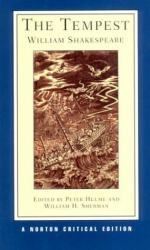|
This section contains 358 words (approx. 1 page at 400 words per page) |

|
The Tempest Summary & Study Guide Description
The Tempest Summary & Study Guide includes comprehensive information and analysis to help you understand the book. This study guide contains the following sections:
This detailed literature summary also contains Further Study and a Free Quiz on The Tempest by William Shakespeare.
Critical consensus places the composition of The Tempest sometime in the years 1610-11. Its first recorded performance was before King James I on November 1, 1611, making it one of the last, if not the last, drama that Shakespeare produced without the help of a collaborator.
Although regarded as one of the dramatist's most original works, The Tempest is said to have been influenced by a number of texts, including Michel de Montaigne's essay "Of the Cannibals" (translated into English in 1603), Sylvester Jourdain's A Discovery of the Bermudas (1610), A true Declaration of the estate of the Colony in Virginia (1610), as well as other accounts of exploration and discovery in the New World. In terms of plot, several possible sources have been put forth, though none contain more than scant resemblances to Shakespeare's play. Thus, many scholars agree with the assessment of Frank Kermode that the genesis of The Tempest is in no single work, but in a body of formal literature and folklore that typically features a magician, a lovely young princess, and a group of stranded courtiers and commoners.
The work is said to be of a piece with Shakespeare's other late plays, which, though comedies, are not without tragic elements and dark undertones. This facet of the play was less frequently noted by early commentators, who stressed both the play's imaginative singularity and depth of observation. However, The Tempest's intermingling of moods has led many recent critics to focus on the complexities and ambiguities of the work. An example of such criticism is that of the play's central character, Prospero, a somewhat mysterious figure who supports many shades of interpretation. Prospero is a magician and the originator of the action in the play. The forces that motivate Prospero include revenge against those who have usurped his power, as well as reconciliation, which is symbolized by the union of Ferdinand and Miranda. Analysis of these motivating factors is central to the critical thought regarding the thematic structure of The Tempest.
Additionally, The Tempest is thought to confront the question of the effects of colonization and civilization on human nature in relation to the Christian theme of redemption.
Read more from the Study Guide
|
This section contains 358 words (approx. 1 page at 400 words per page) |

|



